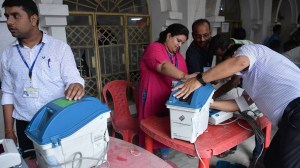- India
- International
Haryana offers paddy farmers incentive to grow maize, pulses
The government will give an incentive of about Rs 10,000 per hectare to the farmers as part of the pilot project that will kick-in soon in seven blocks in the state’s seven out of 22 districts.
 Chief Minister Manohar Lal Khattar announced the pilot project to be launched in Assandh, Pundri, Narwana, Thanesar, Ambala, Radaur and Ganaur blocks.
Chief Minister Manohar Lal Khattar announced the pilot project to be launched in Assandh, Pundri, Narwana, Thanesar, Ambala, Radaur and Ganaur blocks.
To address the problem of dark zones in the state due to its fast depleting water table, Haryana government on Tuesday announced a plan to shift 50,000 hectares under paddy to the crops like maize, pulses or oilseeds from the upcoming cultivation season which starts next month. The government will give an incentive of about Rs 10,000 per hectare to the farmers as part of the pilot project that will kick-in soon in seven blocks in the state’s seven out of 22 districts.
Chief Minister Manohar Lal Khattar announced the pilot project to be launched in Assandh, Pundri, Narwana, Thanesar, Ambala, Radaur and Ganaur blocks. Paddy is produced on 1,95,357 hectares area in these seven blocks, out of which non-basmati paddy is produced in 45 per cent (87,900 hectares) and the main aim of the project is to reduce sowing of paddy on 50,000 hectares area. In Haryana, paddy is sown in 13.5 lakh hectares out of total 35 lakh hectares land under cultivation in the state.
“This scheme would be a unique scheme in the country and Haryana would be the first to implement it in the country,” said the Chief Minister. The state Agriculture and Farmers’ Welfare Department has formulated the scheme keeping in mind the interest of farmers and water conservation. Under the scheme, in seven districts — Yamunanagar, Ambala, Karnal, Kurukshetra, Kaithal, Jind and Sonipat — where majorly paddy and wheat are grown, there is a proposal to reduce area under paddy. Mostly paddy is sown in only ten districts of state’s 22 districts.
The CM said that crop diversification is need of the day for the state as it saves water, electricity and improves soil health. In 1970s, maize and pulses were major crops in Haryana, which have now vanished, and they have been replaced by water guzzling crops such as paddy and wheat.
Apr 19: Latest News
- 01
- 02
- 03
- 04
- 05





























